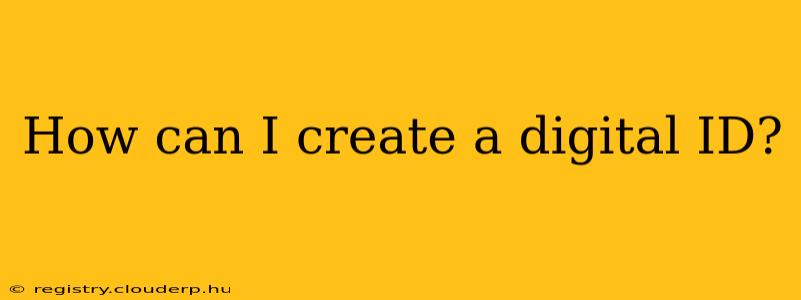How Can I Create a Digital ID? A Comprehensive Guide to Secure Online Identities
The digital world demands secure identification, and creating a robust digital ID is more crucial than ever. This comprehensive guide explores the various methods of generating and managing a digital identity, addressing common concerns and offering practical advice. We'll delve into the different types of digital IDs, their benefits, security considerations, and the steps involved in their creation.
What is a Digital ID?
A digital ID, also known as a digital identity, is a unique electronic representation of your identity. It uses digital credentials to verify your identity online, much like a physical ID card like a driver's license verifies your identity in the real world. This allows you to access online services, prove your age, and conduct transactions securely without revealing unnecessary personal information.
Types of Digital IDs:
Several types of digital IDs exist, each with varying levels of security and functionality:
-
Government-issued digital IDs: These are issued by governmental authorities and often integrate with national identity systems. They usually offer high levels of security and are accepted for a wide range of online and offline transactions. Examples include driver's licenses in some states that include a digital version, or national ID cards in certain countries.
-
Mobile driver's licenses (mDLs): These are digital versions of your driver's license stored on your smartphone, often integrated with your state's DMV app. They provide a convenient and secure way to present your driver's license digitally.
-
Self-sovereign digital identities (SSIs): SSIs give you complete control over your digital identity data. You own and manage your personal information, and you decide what information to share and with whom. This approach emphasizes privacy and data security.
-
Decentralized identifiers (DIDs): DIDs are based on blockchain technology and enable you to manage your digital identity across multiple platforms and services. They provide a high degree of security and interoperability.
How to Create Different Types of Digital IDs:
The process for creating a digital ID varies depending on the type.
1. Government-issued digital IDs: The process typically involves applying through your government's relevant agency (e.g., the DMV for driver's licenses). Check your state's Department of Motor Vehicles website for digital ID options. The specific requirements and procedures vary based on your location.
2. Mobile Driver's Licenses (mDLs): Again, this process begins with your state's DMV website. You may need to download a specific app and then follow the steps to verify your existing driver's license and link it to your mobile device.
3. Self-Sovereign Digital Identities (SSIs) and Decentralized Identifiers (DIDs): Creating an SSI or DID often involves using specific software or platforms designed for digital identity management. These systems often provide tools to create, manage and share your digital identity credentials. You will need to research the available options and choose a platform that fits your needs and risk tolerance.
What are the benefits of having a digital ID?
-
Enhanced security: Digital IDs often employ robust security measures, such as encryption and multi-factor authentication, to protect your identity from unauthorized access.
-
Increased convenience: Access services and complete transactions quickly and easily without needing physical documents.
-
Improved privacy: Some digital ID systems allow you to control which information is shared, reducing the risk of data breaches and misuse.
-
Streamlined processes: Digital IDs can simplify various processes, such as verifying your age or identity for online purchases or account creation.
What security measures should I take to protect my digital ID?
-
Strong passwords: Use strong, unique passwords for all your digital accounts and digital ID platforms.
-
Multi-factor authentication (MFA): Enable MFA wherever possible to add an extra layer of security.
-
Regular software updates: Keep your software and devices up-to-date with the latest security patches.
-
Beware of phishing scams: Be cautious of suspicious emails or websites that ask for your digital ID information.
-
Choose reputable providers: Only use trusted and reputable services for creating and managing your digital ID.
What are the risks associated with digital IDs?
-
Data breaches: While digital IDs often have robust security, there's always a risk of data breaches, which could compromise your personal information.
-
Identity theft: If your digital ID is compromised, it could be used to impersonate you and commit fraud.
-
Privacy concerns: Depending on the digital ID system, there may be concerns about the collection and use of your personal data.
Creating and managing a digital ID requires careful consideration of security and privacy implications. By understanding the different types of digital IDs and the necessary security measures, you can create a secure and convenient online identity. Remember to research and choose the option best suited for your needs and risk tolerance. Consult with security experts if you have any concerns or need assistance setting up a secure digital identity.

